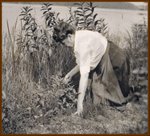 Last winter a pair of pileated woodpeckers took up residence in a large beech tree near the Carriage House (the Visitors Center). About once a week a visitor spots this large bird and excitedly reports it to the naturalist. Note the rather large cavity he excavated on the left side of the limb.
Last winter a pair of pileated woodpeckers took up residence in a large beech tree near the Carriage House (the Visitors Center). About once a week a visitor spots this large bird and excitedly reports it to the naturalist. Note the rather large cavity he excavated on the left side of the limb. Their drumming keeps me company as I work in the garden. It is a thrill to work along side such a gorgeous bird.
Watch for more photos as we try to get a good shot of this funny looking creature.
















